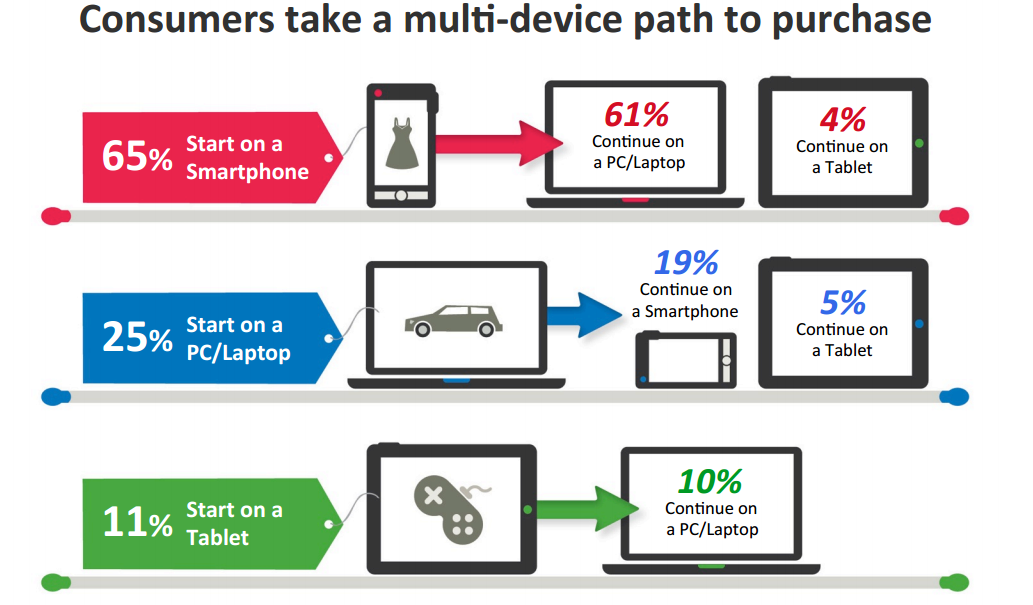I’ll be the first to admit that I’m not a very big tech geek. While I spend most of my workday immersed in fancy Excel formulas and spend a good chunk of my evenings cuddled up with my laptop, that’s about where it ends. My cell phone is not-so-smart and I don’t even own an HDTV (but I’m sort of rooting for my giant tube TV to die one of these days). I did, however, buy an iPod Touch to play music while I worked out and as a distraction tool for my four-year-old son when needed. While the WiFi capabilities are nice, I don’t think I fully appreciated their usefulness until this winter. While I was home on maternity leave, my iPod Touch became my constant companion. While I was trapped on the couch with an eating or sleeping baby, I gained a whole new appreciation for mobile’s role in the online world. I could do a search the moment it popped into my head, rather than having to wait until I could access my laptop—because let’s face it, by that point I’d probably have forgotten what I even wanted to search for. Be it a purchase I wanted to research or a random baby-related question, my internet access pretty much revolved around my mobile device—and has ever since.
When I saw the results of the 2013 Mobile Path-to-Purchase study conducted by xAd and Telmetrics, I realized that I fit right in with current trends. The study looked at 2,000 U.S. smartphone and tablet users and actual observed consumer behaviors from Nielsen’s Smartphone Analytics Panel of 6,000 Apple and Android users. It found that users are increasingly relying on mobile as the starting point of their purchase process, but how a sale was completed differed by device.
Half of those studied said that their initial research into a purchase starts on their mobile device. 31% continue to use the device throughout the purchase process, and 22% of searchers actually complete the purchase on their mobile device. However, 54% of those studied indicate that they also use additional devices for further research. I certainly fell into that category, because as much as I used my iPod, eventually I’d run into a site that wasn’t mobile-friendly or where the ease of a full browser of tabs made comparison shopping easier. The second I could get to my laptop, I’d move the search there.
Interestingly, when it came time to close the sale, behaviors differed between tablet and smartphone users. Sixty percent of smartphone users and 53% of tablet users completed purchases after they researched them on their mobile device. However, while 54% of tablet users completed their purchase online via their mobile device or a PC, the behavior of smartphone users was quite different—74% made their purchase offline.
While the difference between users of two similar devices seems surprising at first, it is less so when you consider how and when the devices are used. Not surprisingly, the majority of those using a tablet do so at home, while smartphones were used more often on-the-go. Those on smartphones might already be out on a mission to make their purchase and are simply looking for directions or store locations to close the sale in person. Additionally, those same folks might decide they need gas or food while they’re out and about, so once again they’d use their smartphone to find the closest business to fit their need and complete the sale in person. In fact, the study found that 1 in 3 smartphone users (and 1 in 4 on tablets) look up contact information, maps, or directions on their device, and 60% percent of all mobile users were looking for businesses within walking or local driving distance from their current location. It makes sense, then, that the conversion rate for smartphone users is higher than for tablet users (60% vs. 53%, as noted above). While tablet users may simply be kicking back on the couch and researching purchases at their leisure, smartphone users are already out and about and faced with a barrage of spur-of-the-moment decisions to make a purchase.
Thanks to my experiences with my mobile device over the past few months, the way I use the internet—and research purchases, in particular—has changed. Based on this study, millions of other mobile users have experienced a similar evolution. It will be interesting to see how these behaviors change in the coming months and years as mobile use continues to grow and more companies focus on improving the mobile experience for their customers. This study shows that there is certainly good reason to do so.
Looking to improve your digital strategy? Contact us today!
Amy Rybczynski, Marketing Research Analyst




